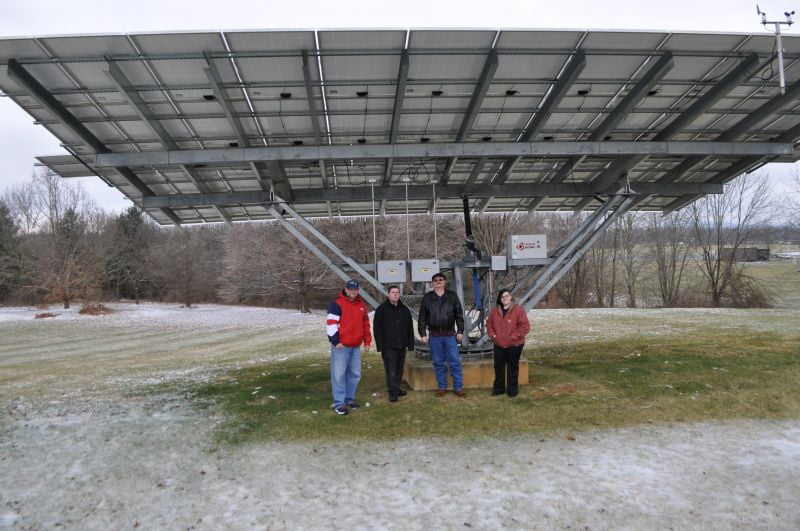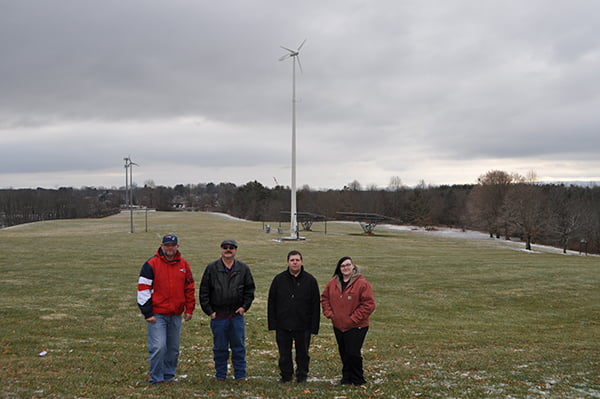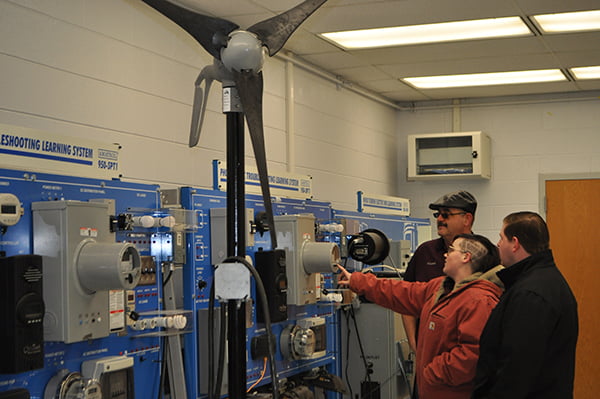It’s 27 degrees, the wind is whipping across the rolling fields and the first thing a visitor sees arriving on NRCC’s Dublin campus is a nimble silver wind turbine spinning above the low, brown buildings flashing in the winter light.

Wind turbines – two more in the distance, with masts 80-feet tall – and two, house-sized, fifty-six-panel solar arrays are scattered in the fields surrounding the school. They are the alternative energy component of the larger NRCC Electronics Technology program, a program that has trained technicians for nearly a decade and now, is beginning to graduate students with alternative energy skills.
Electronics Technology students are applying skills like soldering, wiring and trouble-shooting – practicing on the nimble silver turbine and solar component – to learn theory and skills surrounding solar and wind infrastructure that are increasingly in demand in Virginia.
Two years ago, the state was seventeenth in the nation in solar-panel installation, suddenly leaping to tenth last year, according to a report compiled for the Solar Energy Industries Association.
Now, there are more than 100 solar installers in Virginia, 250 manufacturers and 3, 565 people employed in the Virginia solar industry and the price for solar panels has fallen 43 percent in the last five years.

Even once-coal-heavy Virginia utilities are starting to subsidize solar and to add solar-sourced energy to their resource mixes. And, while wind in not a going concern in Virginia, it is in neighboring states.
That’s why, in an office stacked with NRCC Navigator academic catalogs and an Electronics Trouble Shooting and Repair Handbook the size of a cinderblock, J. Lusk, associate professor, is talking about the Electronics Technology program that he leads and he’s always on the move.
“I had 3 students when I first started in 2009. We’ve got 17 this winter,” he said striding down the wide hall past rooms marked “Process Instrumentation” and “Forensic Science.”
Lusk and the school work multiple levers of outreach, priming the pumps that funnel interested high school and GI-bill veteran students into the program, while at the same time wooing the support of local business that are providing equipment and receiving students as interns, then employees.
Jangling keys to unlock the door of the Electronics Technology lab he talks about the importance of building connections between the program that generates technicians and local industry that needs their skills.
“We’ve got new oscilloscopes, new power supplies. It’s equipment necessary to maintain what students do in the classroom and what they will do in the real-world,” he said apologizing for a messiness that only he can see.
The tidy shelves are lined with oscilloscopes, frequency generators, power-supply boxes, soldering kits, pincer-ended red and black wires neatly coiled.
Oscilloscopes were recently donated by VPT Power – a critical piece of equipment that display electronics waves allowing a technician to see if what she’s working on actually is working properly.
“It’s real world application,” Lusk said, “They’ve got to build it. If they were a technician at VT Power or Moog they would have to trouble-shoot, so they learn how to trouble-shoot here, so when they go out working in the field, they’re better prepared.”
Three of his students, Kari Croy, 19, Stephen Earhart, 23, and Travis Jarrells, 35 nod agreement.
“We tend to work together and help each other out in our struggling points,” Earhart said.
What are the hard points? Math?
“Well, there’s a curve,” Croy added. “that if you don’t know trig and a little calculus you may struggle a little bit, but we have tutors and people to help you we are there for each other through all this.”
Lusk encourages students to work together to problem-solve, use the equipment and puzzle out why something isn’t working.
“Some of the trouble-shooting can be a struggle for some people, but I’ll have students like these guys and they will help other students trouble-shoot.”
Lusk leads the way down shining halls past Industrial and IT labs.
Everybody pulls on hats and gloves to head out into the fields, down the hill in the rime-crunchy yellow grass to the towering turbines, too big to run with light wind, and two solar arrays dripping with icicles that supply a percentage of energy to the school’s administration building saving the school nearly $2000 dollars a year.
Together, Croy, Earhart, and Jarrells represent the diversity of ages and backgrounds found in the program.
Standing in the wind, under the frozen solar panels this group of young people and their teacher are clearly interested and excited by their field and the world it opens to them.
At 23, Stephen Earhart will graduate in December.
“I’m working across a couple of programs currently,” he said. “Mostly Electrical Enginerering and Elecectrical Technology.
He came to the program already technologically inclined.
“I went through a lot of courses in the Career and Technical Education classes in Pulaski High School: the electrical program, completed a welding program, automotive and I did a little carpentry,” he said.
He knew where he was going even in high school.
“I had my hand in everything. I tried to learn my best and see which one I’d go into as a career later on.”
He liked electronics.
“Pretty much electronics,” he said. “I repair old game systems and for my senior project, I repaired a drone for Radford High School.”
Kari Croy, at 19, came armed too – already interested in alternative energy and electronics technology, she checked off a list of skills before she even graduated from the Giles County Technology Center.

“When I was in high school I took the drafting program, so I’m already a certified mechanical drafter, I got that before I graduated high school. But my main take-off from that was that we competed in Skills USA.
We worked on a wind turbine project that heated an element in a watering trough for cattle on the Ag. Lab. And my school made it all the way to nationals and we placed ninth in the nation.”
Skills USA project gave her multiple layers of experience with alternative energy applications and her friendship with Stephen guided her into electronics technology.
“When we were doing the Skills USA project, we had all the equipment to make everything work, it was other components that led into electronics technologies and I gathered more information when I became friends with Stephen. That guided me into both of the paths.”
Travis Jarrells, who, at 35, come to the program with limited direct experience in electronics, says he values the hands-on approach his classes take “instead of just looking at things in a text book.”
“I have a background in the military. I was in the Army for six years and I’m using my GI bill to come back to school. I’m doing Electrical Engineering and Electronics Technology.”
Jarrells was a photographer and set up satellites. He didn’t work with electronics, but he’s a quick learner said Lusk and wanted this as a career path.
“With that background,” Lusk said of Jarrells, “that will help him with drones. Phantom III drones have GoPro cameras on them. 480 resolution to a 40K resolution just by switching out a board,” he said. “People take them on job sites for completion status. Real estate to film outside and inside. Drones are really taking off,” he said. They all laughed. “The sky’s the limit for drones.”
When asked for advice they might give to people thinking about electronics technology all three students talked about the value of the knowledge – just knowing how things work – its applicability in anybody’s life and in 21st century work.
“I would give out there that even at the age I am and older, you can still come in and learn this program, you have a lot of good professors that can really help you get on track and be a success in the world out there,” Jarrells said.
“And there are so many applications that this stuff fits into,” Croy added. “Even if it’s switching out a simple breaker in your home, it all fits together.”
As the group walked back up the frozen hill, Croy said she’s excited that she’s doing this thing she has wanted to do and graduating in May. She speaks with exclamation points.
“Yes. Yes!” she said. “It is very exciting. I love reading about it and finding another wind farm that pops up and other solar panels on tiny houses…everything.“
For Earhart, the choice of work in this field seems natural.
“Yes ma’am,” he said. “I find it very entertaining along with challenging. In the sense that it’s more of a hobby for me. I’ve been working with electronic devices for a good long while,” he said. “I was always told that, “If you do something you love, you’ll never work a day in your life.”


